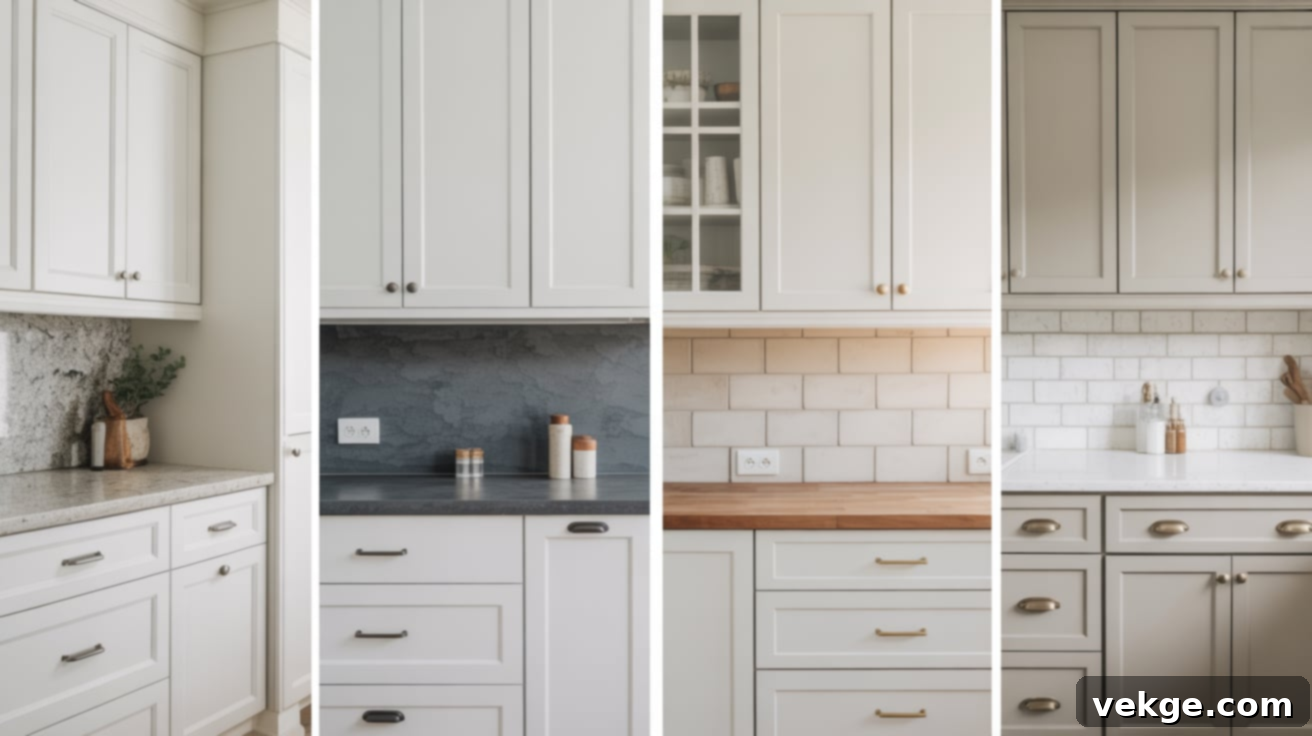The Ultimate Guide to Choosing the Perfect White Paint for Your Kitchen Cabinets
White kitchen cabinets are a timeless choice, renowned for their ability to make any space feel clean, open, and inviting. They offer a versatile backdrop that complements nearly any design style, from ultra-modern to rustic farmhouse. However, the seemingly simple task of selecting the “right” white paint can quickly become overwhelming. You might find yourself staring at a dozen samples, wondering why they all look identical on the paint chip, only for them to transform dramatically once applied to your kitchen walls or cabinets.
Suddenly, what looked like a pure white can appear sickly yellow, another might cast a cold, sterile blue hue, and none seem to align with the bright, airy vision you had in mind. This common predicament leaves many homeowners feeling stuck and unsure. This comprehensive guide is designed to demystify the process, equipping you with the knowledge and confidence to choose the perfect white for your kitchen cabinets.
We’ll delve into the subtle but powerful world of paint undertones, explore how different lighting conditions can alter a white shade, and share expert-recommended white paint colors that consistently perform well in real kitchens. Furthermore, you’ll learn practical strategies for testing paint samples effectively, understanding the importance of various finishes, and discovering safer, budget-friendly options that perfectly suit your home’s aesthetic and your daily lifestyle.
Understanding the Subtle Power of White Paint Undertones
While white paint might initially appear straightforward, its complexity lies hidden in its undertones. These are the subtle background colors that influence how a white shade presents itself in a space. Far from being uniform, every white paint carries a faint hint of another color, and these undertones are crucial in determining the overall mood and warmth of your kitchen.
Before you commit to a specific shade, understanding how undertones function and why they are so significant will be your most valuable tool in achieving your desired aesthetic.
What Exactly Are Undertones?
Think of an undertone as the underlying hue that peeks through the dominant white. It’s the color that makes a white feel either warm or cool, crisp or creamy. These subtle tints are not always immediately obvious, but they become strikingly apparent when placed next to other colors or under different lighting conditions.
- Warm Undertones: Whites with yellow, cream, or sometimes pink/red undertones evoke a cozy, inviting, and soft ambiance. They tend to feel less stark and can make a large kitchen feel more intimate.
- Cool Undertones: Whites that lean towards gray, blue, or even green undertones offer a crisp, clean, and often more modern feel. They can make a space feel expansive and airy, but in certain lights, might appear colder.
- Greige Undertones: A popular blend of gray and beige, greige undertones provide a balanced neutrality. These whites are wonderfully versatile, bridging the gap between warm and cool, making them ideal for spaces with mixed elements.
How Undertones Influence Your Kitchen’s Mood, Warmth, and Style
The chosen undertone of your white paint plays a pivotal role in shaping the atmosphere of your kitchen:
- Warm whites foster a sense of comfort and relaxation. They are an excellent choice for creating a homey, traditional, or farmhouse kitchen aesthetic, pairing beautifully with natural wood elements, brass hardware, and soft lighting.
- Cool whites lend themselves to a more refined, contemporary, and often minimalist look. They are perfect for achieving a crisp, calm, and uncluttered environment, frequently chosen for modern designs featuring stainless steel, chrome, and sleek finishes.
- Greige undertones offer a sophisticated balance, making them incredibly adaptable. They are particularly well-suited for transitional kitchens that blend different styles or incorporate a diverse palette of colors and materials, ensuring harmony without leaning too heavily in one direction.
Matching Undertones with Your Kitchen’s Existing Elements
The key to a cohesive kitchen design is ensuring your chosen white paint harmonizes with other permanent fixtures. Consider these interactions:
- Countertops: If your countertops have warm veining (e.g., creams, browns), a warm white cabinet paint will create a unified look. For cool-toned countertops (e.g., grays, blues), a cool white or a balanced greige might be more appropriate.
- Flooring: Dark wood floors often benefit from a brighter, cleaner white to create contrast, while lighter floors might call for a softer, slightly warmer white to maintain a relaxed feel.
- Backsplash & Wall Colors: Ensure your white cabinet paint doesn’t clash with your backsplash. A white with a yellow undertone might appear dingy next to a stark cool white tile. Similarly, if your walls are a different shade, ensure the cabinet white complements rather than competes.
- Appliances & Hardware: Stainless steel appliances often pair well with cooler or neutral whites. Gold or brass hardware can enhance the warmth of creamy whites, while matte black hardware can create a striking contrast with both warm and cool whites.
The Critical Role of Lighting in Your Kitchen
Beyond undertones, lighting is perhaps the single most influential factor in how white paint appears in your kitchen. A white that looks perfect in a brightly lit showroom can drastically change under different natural or artificial light sources in your home. Understanding this interaction is crucial for making an informed decision.
Natural Light: North, South, East, West Exposures
- North-facing rooms: These kitchens receive cooler, indirect light throughout the day. Cool whites can appear even colder, sometimes feeling stark or shadowy. Warm whites can counteract this, adding a much-needed glow and preventing the space from feeling dull or unwelcoming.
- South-facing rooms: Bathed in bright, warm light for most of the day, south-facing kitchens can handle cooler whites, which will still appear vibrant without feeling icy. Warm whites might intensify, looking more yellow or creamy than desired.
- East-facing rooms: Enjoy bright, warm light in the morning, which fades to cooler tones in the afternoon. A balanced greige or a very neutral white might be best here, appearing welcoming in the morning and retaining its character as the light shifts.
- West-facing rooms: Receive softer, cooler light in the morning, which transitions to intense, warm light in the afternoon and evening. Similar to east-facing rooms, a versatile white that doesn’t lean too heavily warm or cool can manage these shifts gracefully.
Artificial Lighting: A Game Changer
Your choice of light bulbs also significantly impacts how white paint is perceived. Different color temperatures (measured in Kelvins) can dramatically alter the appearance of your cabinets:
- Warm White (2700K-3000K): These bulbs emit a yellowish glow, enhancing the warmth of any white paint. They can make cool whites appear less stark and warm whites even cozier.
- Cool White/Daylight (3500K-5000K+): These bulbs mimic natural daylight, providing a clearer, bluer light. They bring out the cool undertones in paint and can make warm whites appear muted or slightly off. For a truly crisp white, these bulbs often work best.
Consider the placement of your artificial lighting too – overhead lights, under-cabinet lighting, and accent lighting all contribute to the overall effect. Always observe your paint samples under both natural daylight and your typical evening artificial lighting.
Top White Paint Picks for Kitchen Cabinets: Expert Recommendations
To help narrow down your choices, here are some of the most trusted and versatile white paints, beloved by designers and homeowners alike, categorized by their general characteristics to suit various kitchen styles and preferences.
1. Benjamin Moore White Dove (OC-17)

Benjamin Moore White Dove is a perpetually popular choice, striking a perfect balance between a crisp, clean white and a soft, inviting one. It possesses a very subtle gray undertone that prevents it from looking overly creamy or too stark. This characteristic makes it incredibly adaptable, pairing effortlessly with a wide array of finishes, from rich woods and darker countertops to modern stainless steel appliances and black cabinet hardware. White Dove has a slightly warm edge, making it feel welcoming without appearing yellow. It’s an ideal selection for kitchens seeking a touch of contrast and sophisticated warmth without committing to an overtly creamy or cool aesthetic. Its versatility allows it to seamlessly bridge various design elements, making it a go-to for many design projects.
2. Benjamin Moore Simply White (OC-117)

For those desiring a white that feels truly bright yet inherently calm and welcoming, Benjamin Moore Simply White is an exceptional option. This particular shade carries a delicate warmth, almost imperceptibly, which helps to soften its brightness, ensuring your kitchen feels inviting rather than harsh or sterile. It harmonizes beautifully with natural wood floors, existing off-white walls, or warmer-toned tile backsplashes. Simply White excels in spaces that may not receive an abundance of natural daylight, as its luminous quality helps to amplify and bounce whatever light is available, effectively brightening the room. It proves highly flexible in kitchens with a mix of tones in their finishes, trim, or flooring, providing a cohesive and uplifting foundation.
3. Benjamin Moore Chantilly Lace (OC-65)

Benjamin Moore Chantilly Lace is frequently chosen by homeowners and designers who crave a pure, unadulterated white – a truly no-nonsense shade. It is remarkably bright and clean, characterized by a crisp tone that doesn’t visibly lean towards either warm or cool undertones. This makes it one of the most neutral whites available on the market, offering a true white canvas. It performs exceptionally well in kitchens featuring white marble countertops, brushed silver hardware, or modern, minimalist lighting fixtures. In kitchens blessed with an abundance of natural light, Chantilly Lace maintains its sharp and clear presence, enhancing the architectural details of molding, intricate tile work, or even sculptural elements, allowing them to truly shine.
4. Benjamin Moore Cloud White (OC-130)

For kitchens that exude a cozier, more traditional, or even slightly rustic charm, Benjamin Moore Cloud White presents itself as a wonderful option. It possesses a gentle, creamy quality that feels inviting without being excessively heavy or yellow. This soft white integrates seamlessly with various wood tones, classic brass hardware, or muted stone finishes, enhancing their natural beauty. Cloud White is adept at softening the overall appearance of your kitchen, contributing to a warm and welcoming ambiance without crossing into an overly buttery or yellow territory. It’s particularly effective in homes with existing warm-toned flooring or older architectural features that you wish to preserve and celebrate while updating your cabinets with a fresh, yet classic, touch.
5. Benjamin Moore Paper White (OC-54)

If your kitchen is fortunate enough to receive ample natural light throughout the day, Benjamin Moore Paper White is a sophisticated choice worth considering. This elegant white features a subtle blue-gray base, imbuing it with a quiet, clean, and refreshing feel. As a distinctly cooler white, it creates beautiful pairings with cool-toned accents such as silver hardware, navy island cabinetry, or charcoal gray elements. It’s crucial to exercise caution with this shade in darker kitchens, as insufficient light can cause it to appear more gray than white, losing its luminous quality. However, in spaces with abundant natural illumination, Paper White successfully maintains a fresh and airy mood without feeling overly sharp or clinical, offering a serene backdrop.
6. Sherwin-Williams Alabaster (SW 7008)

Sherwin-Williams Alabaster is a universally adored white known for its soft, creamy base that imparts a wonderfully relaxed and organic feel. It strikes an excellent balance, being warm enough to feel incredibly inviting and cozy, yet still sufficiently light to brighten and uplift your kitchen space. Alabaster excels when paired with rich gold or brass hardware, as well as natural stone countertops that feature warm undertones. If your primary goal is to cultivate a calm, comfortable, and sophisticated atmosphere in your kitchen, Alabaster stands as a highly dependable and popular option. Its ability to blend effortlessly with both new, modern finishes and existing, older elements makes it an excellent transitional color, harmonizing diverse design styles.
7. Sherwin-Williams Pure White (SW 7005)

When the objective is a basic, highly dependable white that exhibits minimal shifts in varying lighting conditions, Sherwin-Williams Pure White is an outstanding candidate. Its greatest strength lies in its remarkable neutrality; it lacks strong discernible undertones, which greatly simplifies the process of matching it with any other finish or material present in your kitchen. Whether your space features rich wood, luxurious marble, or practical ceramic surfaces, this white maintains its balanced and consistent appearance. Pure White is a frequent choice in new construction homes or extensive kitchen renovations where a single, reliable white is needed to unify walls, trim, and cabinetry, providing a clean and universally appealing aesthetic.
8. Sherwin-Williams Origami White (SW 7636)

Sherwin-Williams Origami White offers a sophisticated blend of gray and beige within a soft white base, positioning it firmly in the versatile greige category. This unique composition helps to soften kitchens that might otherwise feel too stark or one-dimensional. If your kitchen incorporates neutral-toned tile, mixed metal hardware, or a variety of textures, Origami White integrates beautifully without getting lost or feeling overwhelmed. It provides a comfortable and understated shade that particularly suits homes where different materials and textures are layered together to create depth and interest. You’ll find that this shade consistently holds its nuanced tone across a diverse range of lighting scenarios, making it a reliable and elegant choice.
9. Sherwin-Williams Extra White (SW 7006)

Sherwin-Williams Extra White is a striking choice often selected when a high-contrast, exceptionally clean look is desired. Its crisp, cool undertone lends a fresh and modern edge, making it an excellent pairing for bold cabinet pulls, dramatic navy-painted islands, or dark wood flooring where a strong visual pop is beneficial. This cool-leaning white performs optimally in spaces that receive an abundance of natural daylight, as it can otherwise feel too cool or stark in dimly lit areas. If your kitchen design leans towards a clean, minimalist, or contemporary aesthetic, Extra White can effectively support that feel, providing a sharp and pristine backdrop without verging into sterile territory, especially when balanced with other design elements.
10. Sherwin-Williams Snowbound (SW 7004)

Sherwin-Williams Snowbound is a soft, delicate white distinguished by its cool, gentle background. It possesses a subtle hint of gray and a very faint pink-beige undertone that prevents it from appearing overly stark, giving it a comforting depth. Snowbound works beautifully when combined with other cool-toned elements, particularly blues and greens, whether in tile backsplashes, painted walls, or decorative accents. Its slight gray touch helps maintain a sense of calm and order, even in bustling kitchens. This shade is particularly useful when you desire a white that elegantly supports and complements other colors in your palette rather than overtly asserting itself, offering a sophisticated and harmonious foundation.
11. Behr Ultra Pure White (UPW)

For a straightforward, bright white that is both readily accessible and reliably consistent, Behr Ultra Pure White is an excellent choice. This true white is celebrated for its remarkable neutrality; it does not exhibit strong undertones and maintains its pure hue across various lighting conditions, making it incredibly easy to work with. This characteristic makes it especially practical if you are painting multiple areas of your home and desire a consistent, uniform white throughout. Ultra Pure White is also a go-to for rental properties or home flips, where a clean, crisp look is essential, and the need for extensive tone matching is minimized, offering a dependable and fresh aesthetic with minimal fuss.
12. Valspar Swiss Coffee (7002-16)

Valspar Swiss Coffee is a wonderfully soft, warm white that excels in creating a gentle, inviting atmosphere. Its creamy quality makes it an ideal companion for natural wood tones, other cream colors, or soft tan accents. This shade imbues your kitchen with a cozy, comfortable feeling, harmonizing beautifully with older cabinetry, rustic tile work, or warm-toned stone features. While it may not be the best fit for kitchens dominated by cooler grays or blues, if your space already leans towards warmth and comfort, Swiss Coffee will undoubtedly enhance and support that welcoming look, providing a subtle richness without being too overpowering.
13. Farrow & Ball All White (No. 2005)

For discerning homeowners seeking an exceptionally clean white that possesses absolutely no discernible warm or cool bias, Farrow & Ball All White is a superb and sophisticated choice. Uniquely formulated without any added pigments, what you see is a truly pure white, offering unparalleled clarity. This makes it an outstanding selection for kitchens where you have bold flooring, vibrant backsplash tiles, or colorful decor elements that you wish to highlight without any color competition from the cabinets. All White is simple, steadfast, and holds its pristine character exceptionally well in kitchens featuring modern finishes, abundant clear lighting, and an overall minimalist or gallery-like aesthetic.
Choosing the Right White for Your Kitchen: A Holistic Approach
Finding the perfect white paint for your kitchen cabinets goes beyond simply selecting an appealing color. It requires a thoughtful consideration of your kitchen’s inherent style, its unique lighting conditions throughout the day, and the existing finishes and materials that define the space. Some whites are magnificent in natural light, while others truly shine in warmer, more artificially lit environments. To assist you in making the most informed decision, here’s an expanded breakdown based on common kitchen features and design considerations:
| Factor | Detailed Considerations for Choosing White Paint |
|---|---|
| Kitchen Style | Modern/Minimalist: Opt for crisp, cool, or truly neutral whites like Benjamin Moore Chantilly Lace or Sherwin-Williams Extra White. These enhance clean lines, sleek surfaces, and often feature stainless steel or chrome. |
| Farmhouse/Rustic: Embrace warm, soft whites such as Sherwin-Williams Alabaster or Valspar Swiss Coffee. These pair beautifully with natural wood beams, distressed finishes, and rustic accents, creating a cozy and inviting atmosphere. | |
| Transitional: Choose versatile greige-based whites like Sherwin-Williams Origami White or Benjamin Moore White Dove. These comfortably blend elements from both traditional and contemporary styles, offering balance and sophistication. | |
| Traditional/Classic: Creamy whites with a subtle warmth, like Benjamin Moore Cloud White, often complement intricate molding, classic hardware (e.g., brass, antique bronze), and rich wood furniture. | |
| Existing Finishes | Cool-Toned Counters (e.g., gray marble, soapstone): A warm white for cabinets can provide a beautiful, softening contrast. Alternatively, a cool white can create a cohesive, monochromatic look. |
| Warm-Toned Counters (e.g., beige granite, wood butcher block): Consider a cooler or very neutral white to balance the warmth, or a creamy white to enhance the existing cozy feel. | |
| Tan or Beige Backsplash: A cooler white cabinet paint can prevent the space from looking too yellow and keep things feeling fresh and balanced. | |
| Dark Wood Floors/Accents: A brighter, more luminous white will create a striking contrast, making the cabinets pop and bringing light into the space. | |
| Light Floors/Accents: Softer, perhaps slightly warmer whites will blend more seamlessly, contributing to a relaxed and airy feel, avoiding too much starkness. | |
| Lighting Conditions | Abundant Natural Light (South-facing): Cooler whites can thrive here without feeling sterile. Be cautious with warm whites, which might appear overly yellow. |
| Limited Natural Light (North-facing/Interior): Warm whites can significantly brighten and soften the space, making it feel more comfortable and less gloomy. Cool whites might intensify feelings of coldness. | |
| Mixed Light (East/West-facing): A balanced, neutral white or a subtle greige often performs best, adapting gracefully to the changing light quality throughout the day. | |
| Artificial Light (Bulb Temperature): Always test samples with your actual light bulbs (warm vs. cool LEDs) to see their true color. Warm bulbs enhance warmth, cool bulbs emphasize coolness. |
Mastering Paint Finishes for Your Kitchen Cabinets
The sheen, or finish, of your paint is just as important as the color itself, especially for kitchen cabinets which endure significant wear and tear. The right finish impacts durability, ease of cleaning, and the overall aesthetic. Here’s a breakdown of common paint finishes and their suitability for cabinets:
- Matte/Flat: Offers a non-reflective, sophisticated look. However, it’s generally not recommended for cabinets due to its porous nature, which makes it difficult to clean and prone to scuffs and stains.
- Eggshell/Satin: These are the most popular choices for kitchen cabinets. They offer a slight sheen, making them more durable and easier to wipe clean than matte. Satin has a bit more luster than eggshell and is excellent for hiding minor imperfections while providing good protection.
- Semi-Gloss: Provides a noticeable shine, offering superior durability and washability. It’s highly resistant to moisture and grime, making it an excellent choice for high-traffic areas like kitchens. However, its higher sheen can highlight imperfections on cabinet surfaces.
- High-Gloss: Delivers a mirror-like finish, offering maximum durability and ease of cleaning. It’s often used for modern, high-impact looks. Be aware that high-gloss surfaces will accentuate every flaw and require perfectly smooth cabinet surfaces.
For kitchen cabinets, a **satin or semi-gloss finish** is generally recommended. They strike the best balance between aesthetics, durability, and practicality for a busy kitchen environment.
Testing Paint Before You Commit: Your Essential Step
White paint is notoriously deceptive. What looks perfect on a small swatch in the store or on a screen can appear entirely different once it covers your cabinets. Environmental factors such as natural light, artificial lighting, existing wall colors, and surrounding finishes all interact with the paint to alter its perception. This is precisely why thorough testing is not just recommended, but absolutely essential to prevent costly mistakes and ensure your satisfaction.
A few extra minutes and a small investment in samples now can save you significant time, money, and frustration down the line.
- Don’t Paint Directly on Cabinets (Yet): Avoid painting samples directly onto your existing cabinets. The old color can bleed through or influence the perception of the new white.
- Use Large Sample Boards: Purchase sample jars of your top 2-3 white choices. Paint two coats on large foam core boards (at least 2×2 feet) or sturdy poster board. This gives you a substantial area to assess the color. Alternatively, use peel-and-stick samples for a mess-free option, ensuring they are large enough.
- Place Samples Vertically: Always view your samples vertically, as they would appear on your cabinets. Colors look different when laid flat.
- Test in Various Locations: Move your painted boards or stick-on swatches around the kitchen. Place them next to your countertops, backsplash, near the window, under existing artificial light fixtures, and in both sunny and shadowy corners.
- Observe at Multiple Times of Day: The lighting in your kitchen changes dramatically from morning to afternoon to evening. Observe your samples at different points throughout the day to see how the white shifts under varying natural and artificial light conditions. Pay attention to how undertones emerge or recede.
- Compare Against Existing Elements: Hold your samples up against your flooring, existing wall paint, appliances, and any permanent fixtures (like a fireplace or built-in shelving). Ensure harmony with these elements.
- Take Your Time: Live with the samples for a few days if possible. This allows you to truly gauge how the color interacts with your home’s unique environment and your daily routine.
- Pick the Most Consistent Shade: The white that looks consistently good from sunrise to evening, and harmonizes with all your existing elements, is likely the safest and best choice for your kitchen cabinets.
Healthier & Budget-Friendly White Paint Solutions
In addition to aesthetics, considering health and cost are vital for any home improvement project. Modern paint technology offers excellent options that are both safer for your family and easier on your wallet.
- Low-VOC (Volatile Organic Compound) Paints: Many premium brands now offer low or zero-VOC paints. These paints emit fewer harmful chemicals into the air, improving indoor air quality and making them a healthier choice, especially in a kitchen where food is prepared. Look for certifications like GREENGUARD.
- Durable & Washable Formulas: Investing in a higher quality, durable paint specifically formulated for cabinets can be budget-friendly in the long run. These paints resist chipping, fading, and can withstand frequent cleaning, reducing the need for touch-ups or repainting. Look for terms like “enamel,” “cabinet & trim paint,” or “urethane-fortified.”
- DIY vs. Professional Painting: Painting kitchen cabinets yourself can significantly cut costs. However, it’s a labor-intensive project requiring proper preparation (cleaning, sanding, priming) for a professional-looking finish. If budget is a major concern, consider tackling the project yourself after thorough research and practice.
- Consider Budget-Friendly Brands: While Benjamin Moore and Sherwin-Williams are often designer favorites, brands like Behr (Home Depot) and Valspar (Lowe’s) offer excellent quality paints with comparable colors at a more accessible price point. Don’t shy away from these options; their “Ultra Pure White” or “Swiss Coffee” alternatives are often fantastic performers.
Final Thoughts: Your Confident Choice Awaits
Choosing the perfect white paint for your kitchen cabinets can feel like a daunting task, but with the insights and strategies shared in this guide, you now possess the tools to navigate this decision with confidence. You’ve uncovered the intricate influence of undertones, understood how dynamic lighting conditions can transform a shade, and explored a curated list of expert-recommended white paints that stand the test of time and trend.
Moreover, you’re now equipped with a practical approach to testing paint samples effectively, understanding the crucial role of different paint finishes, and recognizing healthier, budget-friendly solutions that align with your lifestyle. By applying these principles, you can move forward feeling empowered to select a white that not only brightens your kitchen but also perfectly complements your home’s unique character and your personal aesthetic.
If you’re still seeking further inspiration or require more specific guidance on color pairings, design styles, or other home improvement projects, we encourage you to explore our other insightful posts. Your dream kitchen is within reach, and we’re here to help you take that next step with absolute assurance.
